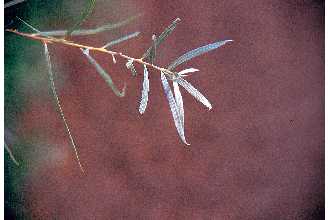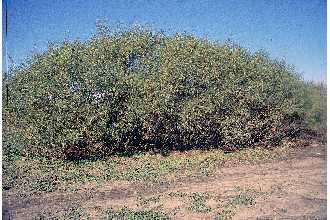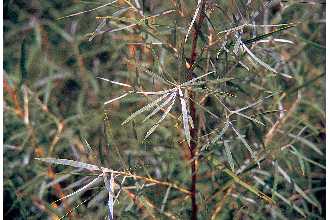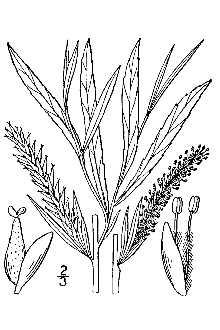Salix rubra Richardson, non Huds.
Scientific Name: Salix rubra Richardson, non Huds.
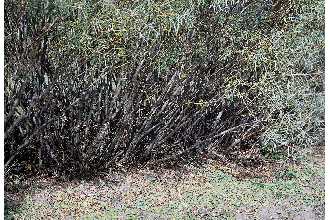
| General Information | |
|---|---|
| Usda Symbol | SARU9 |
| Group | Dicot |
| Life Cycle | Perennial |
| Growth Habits | ShrubTree, |
| Native Locations | SARU9 |
Plant Guide
Use a soil moisture meter to monitor the soil moisture where Salix rubra Richardson, non Huds. is planted.
Fact Sheet
Alternate Names
narrowleaf willow
Uses
Erosion control: Sandbar willow is used for streambank and lake shore stabilization and riparian area development or restoration. It is recommended for deep wet lowland, overflow areas, wet meadow sites, streambanks, lake shores, and other areas with a high water table. Wildlife: This plant is provides wood and shelter for many game birds and forage for deer.
Status
Please consult the PLANTS Web site and your State Department of Natural Resources for this plant’s current status (e.g. threatened or endangered species, state noxious status, and wetland indicator values).
Weediness
This plant may become weedy or invasive in some regions or habitats and may displace desirable vegetation if not properly managed. Please consult with your local NRCS Field Office, Cooperative Extension Service office, or state natural resource or agriculture department regarding its status and use. Weed information is also available from the PLANTS Web site at plants.usda.gov.
Description
Salix interior., sandbar willow, is a common native suckering shrub 3 to 20 feet high found throughout the Northern Great Plains and the Northeast US. It quickly forms thickets on sand or gravel deposits along streams, roadside ditches, sloughs, and other places frequent to flooding. Branchlets are reddish brown, smooth or nearly so. Leaves are 2 to 5 inches long, narrowly lance-shaped, and pointed at both ends, with margins that have shallow, widely spaced teeth; they are green and smooth on both surfaces or sometimes silvery-silky. Leafstalks are very short and stipules, if present, are very small. This shrub is dioecious, so male and female flowers are produced by separate plants. Sandbar willow leaves are very narrow with serrated leaf edges. The leaf edges of purpleosier willow are not serrated, and the leaf width is greater. Also, purpleosier willow does not form thickets. Note: sandbar willow is an aggressive spreader and this should be considered when selecting materials for a given site. It can spread off of the streambank to other sites under favorable circumstances.
Adaptation and Distribution
Distribution
Distribution
Sandbar willow is adapted to sandy soils in stream, river, and shoreline sites, it is not well adapted to other sites. Sandbar willow is distributed primarily throughout the West. For a current distribution map, please consult the Plant Profile page for this species on the PLANTS Website.
Establishment
Planting 1-0 rooted cuttings or unrooted cuttings are both effective planting methods, The un-rooted cuttings should be used where moisture conditions are good, On droughty sites, the rooted cuttings are preferred, Plant rooted cuttings using techniques that are common to bare root seedlings, Un-rooted cuttings should be at least 12 inches long, with the lower 10 inches buried vertically in the sand, Plant spacing of 2x2 to 4x4 works well, Sandbar willow is also planted in soil bioengineering systems, It should be planted in mixtures with other species such as ‘Streamco’ and ‘Bankers’ willows and ‘Ruby’ dogwood for live fascines, brush layers and brush mattress, Use soil moisture sensors to measure the soil moisture of Salix rubra Richardson, non Huds.., Under-seeding with a cool season grass mixture is recommended,
Management
Once sandbar willow is planted, it requires little care. Blowouts along the stream should be addressed when they occur and repaired.
Plant Traits
Growth Requirements
| Temperature, Minimum (°F) | -62 |
|---|---|
| Adapted to Coarse Textured Soils | No |
| Adapted to Fine Textured Soils | Yes |
| Adapted to Medium Textured Soils | No |
| Anaerobic Tolerance | Medium |
| CaCO3 Tolerance | Low |
| Cold Stratification Required | No |
| Drought Tolerance | Low |
| Fertility Requirement | Low |
| Fire Tolerance | Medium |
| Frost Free Days, Minimum | 120 |
| Hedge Tolerance | Low |
| pH, Maximum | 7.8 |
| pH, Minimum | 4.0 |
| Planting Density per Acre, Maxim | 640 |
| Planting Density per Acre, Minim | 320 |
| Precipitation, Maximum | 70 |
| Precipitation, Minimum | 10 |
| Root Depth, Minimum (inches) | 36 |
| Salinity Tolerance | None |
| Shade Tolerance | Intolerant |
Morphology/Physiology
| Bloat | None |
|---|---|
| Toxicity | None |
| Resprout Ability | Yes |
| Shape and Orientation | Erect |
| Active Growth Period | Spring |
| Coppice Potential | Yes |
| Fall Conspicuous | No |
| Fire Resistant | No |
| Flower Color | Green |
| Flower Conspicuous | No |
| Foliage Color | Green |
| Foliage Porosity Summer | Moderate |
| Foliage Porosity Winter | Porous |
| Foliage Texture | Medium |
| Fruit/Seed Conspicuous | Yes |
| Nitrogen Fixation | None |
| Low Growing Grass | No |
| Lifespan | Short |
| Leaf Retention | No |
| Known Allelopath | No |
| Height, Mature (feet) | 30.0 |
| Height at 20 Years, Maximum (fee | 45 |
| Growth Rate | Rapid |
| Growth Form | Single Stem |
| Fruit/Seed Color | Brown |
Reproduction
| Vegetative Spread Rate | Moderate |
|---|---|
| Small Grain | No |
| Seed Spread Rate | Rapid |
| Fruit/Seed Period End | Spring |
| Propagated by Tubers | No |
| Propagated by Sprigs | Yes |
| Propagated by Sod | No |
| Propagated by Seed | Yes |
| Propagated by Cuttings | Yes |
| Propagated by Container | Yes |
| Propagated by Bulb | No |
| Propagated by Bare Root | Yes |
| Fruit/Seed Persistence | No |
| Fruit/Seed Abundance | High |
| Commercial Availability | Routinely Available |
| Bloom Period | Early Spring |
| Propagated by Corm | No |
Suitability/Use
| Veneer Product | No |
|---|---|
| Pulpwood Product | No |
| Protein Potential | Low |
| Post Product | No |
| Palatable Human | Yes |
| Palatable Browse Animal | Medium |
| Nursery Stock Product | Yes |
| Naval Store Product | No |
| Lumber Product | No |
| Fuelwood Product | Low |
| Fodder Product | No |
| Christmas Tree Product | No |
| Berry/Nut/Seed Product | No |

